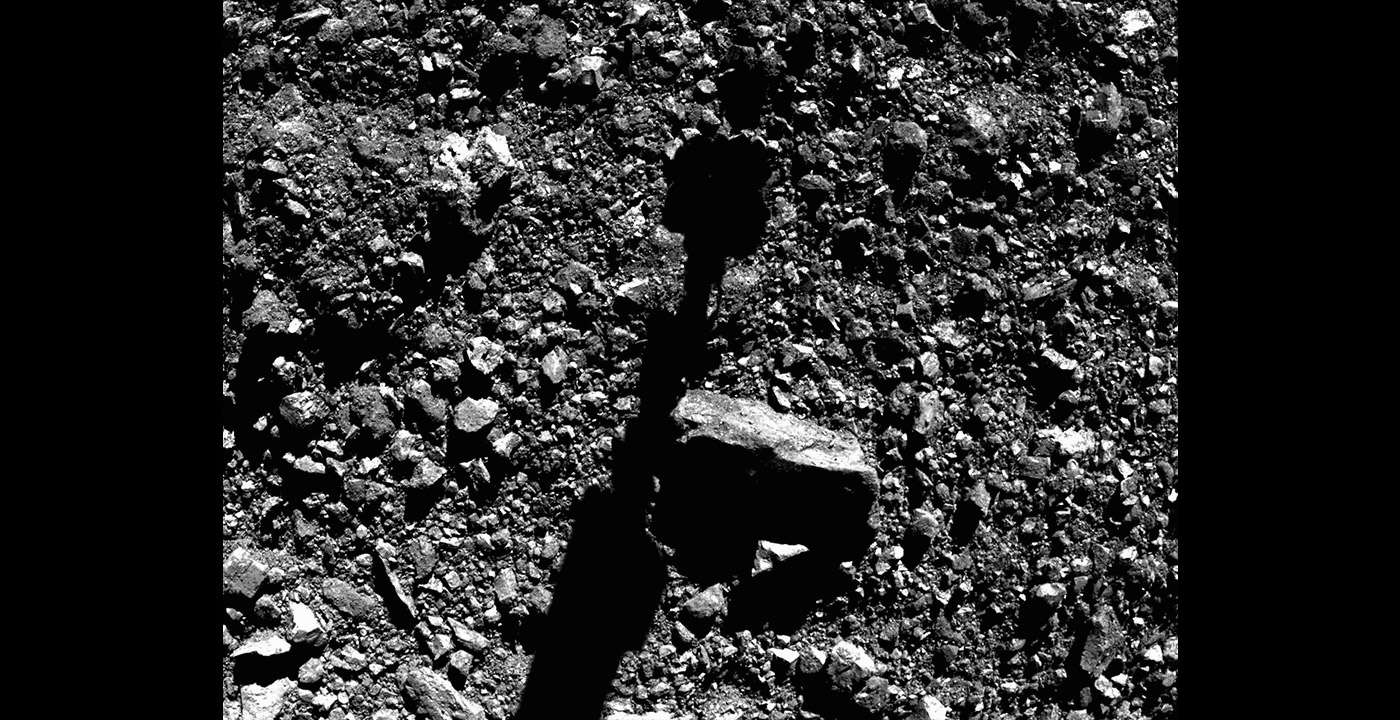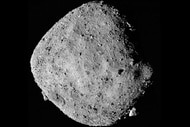Create a free profile to get unlimited access to exclusive videos, sweepstakes, and more!
UPDATE: Incredible footage of OSIRIS-REx tagging an asteroid

Well, OSIRIS-REx has had a busy week.
On 20 October, the spacecraft dropped down to the surface of Bennu, the near-Earth asteroid it's been exploring for two years. A collector head about the size of a car's air filter sat at the end of a long arm, and when it connected to the surface nitrogen tanks blew gas out, disturbing the dust and pebbles and grains there, blasting them up and away from the asteroid. The way the head is made, the gas guided the debris into the collector, where it could be safely stored.
The spacecraft team released a video made from images taken by the OSIRIS-REx navigation camera, showing the process as the spacecraft dropped down to Bennu, blasted it, and moved away.
And it's something. Watch THIS:
This video covers about three hours, starting about an hour after the spacecraft dropped out of orbit and approached the surface. You see Bennu rolling by underneath, huge boulders sticking up imposingly. It appears as if the asteroid is shifting around, but it's actually OSIRIS-REx getting into the right attitude (spacecraft orientation) for the sampling maneuver, and at about 21 seconds into the video the Nightingale landing site hoves into view and things stabilize.
The spacecraft drops down and you can see the soft outline of the ancient crater that carves out the Nightingale site, boulders surrounding it. At 30 seconds, the images come faster, and details just centimeters across are visible. At 00:33, the shadow of the TAGSAM (Touch-and-Go Sample Acquisition Mechanism) slides into the frame, and the collector head touches down just outside the frame to the upper right. The gas jets blow… and then CHAOS.
The spacecraft's momentum pushes the TAGSAM into the surface, compressing the material down to about 48 cm. Then the reverse thrusters fire, and the spacecraft backs out, debris flying everywhere. It looks like there's a small plume of debris to the upper right (but covering most of the frame), loose rocks in the nearly nonexistent asteroid gravity, and the plume shadow to the lower left pointing toward the center of the frame. Right at the end of the video a couple of dark blobs appear on the left, possibly bigger rocks shadowed by the spacecraft; engineers are still investigating what they were.
That video is SO COOL. 330 million kilometers away, totally autonomously, OSIRIS-REx dipped down and grabbed a double handful of rocks off an asteroid that's been circling the Sun for over a hundred million years. In fact, I'll get back to that. Hang on...
What we found out next is that the maneuver worked too well, and the collector was overstuffed with rocks! They hoped to collect about 60 grams of material, but may have easily gotten over a kilogram. Whoa.
The flap to close the container was jammed open by a small rock, and some material was seen coming out. Because of that, engineers decided to forgo a procedure to measure the amount of material, fearing they might lose some if they did. Instead, they decided to go straight to stowing the container into the Sample Return Capsule that will eventually send it to Earth.
As it did so, a camera on board the spacecraft took a series of images as the container was placed in the capsule. I can't embed that here, but if you click through this tweet from OSIRIS-REx you can watch.
Wow. After it was ascertained to be safely stowed, the capsule lid closed:
That lid closing was a big deal; with material possibly coming out of the sample collector, being able to stow everything safely wasn't guaranteed. Nice to see it clamped down nice and tight.
The spacecraft will leave Bennu behind in March 2021 and start the 30-month journey back to Earth. In September 2023 it will eject the capsule, whose blunt cone shape will slow it down as it rams through our air, then descend via parachute into the Utah desert and from there into the hands of many eager scientists.
But wait! There's more.
At around the same time OSIRIS-REx was doing all this, scientists published some interesting results about Bennu. Using OSIRIS-REx data, they saw small craters on large boulders on the surface of Bennu, created when small interplanetary rocks impacted the boulders at high speed as Bennu orbited the Sun. The maximum size of the craters seen is likely just smaller than what's needed to actually crack the boulders apart; the logic being that anything bigger would split the boulder and so it wouldn't still be intact. Lab experiments uphold this idea.
So, by looking at those biggest craters they could infer how strong the boulders are, and found them to be very soft, which isn't too surprising given how easily the TAGSAM crushed material on the surface.
With that info in hand, they could then look at the size distributions of craters on the boulders to get an idea of the population of rocks that hit them. What they found is that they match the size distribution of rocks in the main asteroid belt.
Moreover, they can use the frequency of impacts to look at the age of the boulders, or at least how long they've been exposed to space. What they found is astonishing. It's known that Bennu was formed about 100 million years ago, probably from a bigger asteroid that got whacked by a smaller one, blowing off shrapnel that coalesced into Bennu. But they found that the cratering is consistent with it only being a near-Earth asteroid for about 1.75 million years!
So it formed long ago, but then in recent times (well, astronomically recent) something — likely the gravity of Jupiter — nudged it into its current orbit that brings it near Earth… so close, in fact that it's possible (though very unlikely) it could impact Earth in the next century or two, making it a Potentially Hazardous Asteroid.
That's really important information! If we want to keep Earth safe from big impacts in the long run, we need to understand how asteroids move from the main belt between Mars and Jupiter onto paths that take them near Earth. Getting the age of Bennu this way is a big step in understanding how all this works.
All in all, a great week for asteroid science. It's nice to hear some good news for a change even if that news came from a third of a billion kilometers away.















